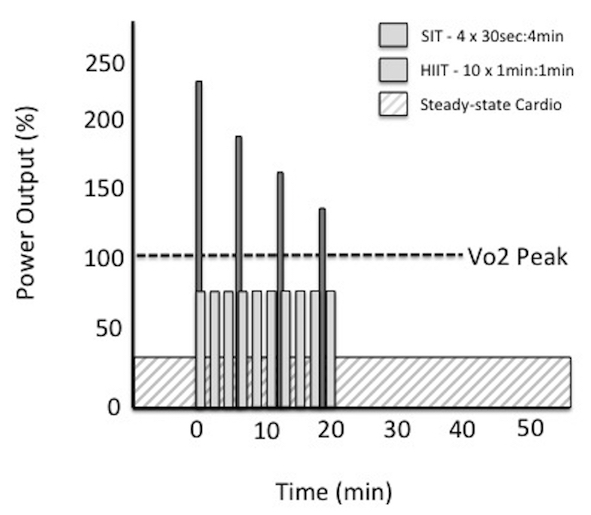Despite conventional thinking (and advice), low-volume high-intensity interval exercise (aka HIIT) results in far greater improvements in cardiometabolic health markers than moderate-intensity endurance training (1, 2, 3, 4, 5). With a multitude of research studies praising HIIT for it’s ability to enhance vascular structure and function (1, 2) increase ventricular mass and stroke volume (1, 2) improve microvascular density and enzyme content, control blood pressure, and enhance endothelial function – even though the commitment in time and effort is MUCH lower.
In 2014, researchers in the journal Menopause, found significant improvements in cardiopulmonary function for a high-intensity exercise group, that were not seen in their continuous training counterparts who exercised twice as long and expended twice the energy.
Endothelial function is arguably the most noteworthy, as it’s a precursor for plaque build-up and the development of atherosclerosis. And though exercise in general appears to be a useful intervention for improving it, and preventing the dysfunction that’s associated with heart disease, only high-intensity exercise enhances it.

Not surprisingly, it’s a similar story with metabolic health. As when matched for energy expenditure, ‘all out’ vigorous physical activity had a greater influence on metabolic syndrome than did moderate intensity physical activity (1, 2). Many times with a total commitment of less than 10 minutes (1, 2)!
Researchers in the European Journal of Applied Physiology had individuals take part in 10 min of leisurely bike riding that included only 1-2 short 10-20-sec bursts during the session. After 3 weeks, the participants not only improved their aerobic capacity significantly, but they increased insulin sensitivity by 28%!
This is largely because of HIIT’s ability to increase fat burning hormones, while preferentially burning muscle glycogen or stored carbohydrates (1, 2, 3). Leading to greater fat loss and insulin sensitivity over time (1, 2, 3, 4), and superior reductions in fasting glucose and triglycerides (1, 2, 3).
HIIT is also unique in that it stimulates fast-twitch muscle fibers, which have a considerable impact on delaying the onset of metabolic disease. As discussed in 1% Fitness, this rapid force production is something that declines with age; and unfortunately it’s not always improved with traditional resistance training (in older individuals). But more importantly, it’s the fiber type that’s sacrificed via extended periods of jogging, cycling and elliptical-ing.

“What about aerobic capacity?”
Vo2max or peak remains a valid indicator of long-term health, as it’s associated with total and cardiovascular mortality whether we currently have heart disease or not. But despite what Runner’s World and Triathlon Tim will tell you, HIIT provides equivalent improvements in a fraction of the time.
Researchers in the Journal Physiology compared 90-120min of continuous cycling at 65% intensity, with 4-6 intermittent sprints of 30-seconds and a 4min recovery between sets. They not only found equal improvements in aerobic capacity in only 2 weeks, but the commitment time for the continuous exercise group was 10.5 hours, compared to only 2.5 hours in the HIIT group!
Realistically, when looking at the difference in power output for HIIT protocols (tall skinny bars below), compared to traditional steady-state cardio (solid striped block below) one has to wonder why anyone would purposely select it to improve vo2max:

Clearly, intensity of exercise has a much bigger impact on Vo2max than duration (1, 2). Just like it has a much bigger impact on the other biomarkers for long-term health – that are commonly attributed to steady-state endurance training.
HIIT stimulates markers of AMPK, increases mRNA and genes responsible for energy and metabolic regulation (PGC-1α), and results in greater mitochondrial function and enzyme activity (1, 2, 3, 4, 5, 6, 7, 8, 9).
In other words, you can keeping wasting time and effort pursuing cardiometabolic improvements via continuous moderate-intensity (aerobic) exercise, or you can do it in a fraction of the time with HIIT. And that’s before considering the excess stress and free radical damage that’s characteristic of chronic cardio.
Stay Lean!
Coach Mike
RELATED ARTICLES:
Cardio - The Worst Investment Ever
Why MORE Exercise Fails For Fat Loss
Sprinting vs Jogging - Go Fast To Burn Fat
